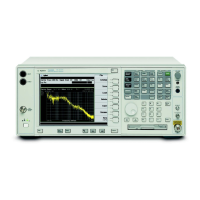102 Chapter 4
Troubleshooting the RF Section (E4446A, E4447A, E4448A)
RF Section Description (E4446A, E4447A, E4448A)
The SBTX bands are bands 5 and 6 whose start (minimum) and stop
(maximum) frequencies are shown in the following table:
The mixing equations are:
Common failures with SBTX/RYTHM are a damaged input switch due
to input overstress, and a faulty preselector. The former can cause
signal loss in any one of the three signal paths, or in all signal paths.
The latter will cause signal loss or flatness problems in high band or the
mm bands above 26.8 GHz.
Troubleshooting involves measuring the signal outputs of the A19
SBTX/RYTHM assembly on another spectrum analyzer and monitoring
the DC switching voltages on the A29 SBTX/FELOMA Driver assembly.
Since the A13 Front End Driver assembly controls the SBTX driver
assembly, also verify the A13 assembly is not the cause of the problem.
Signal Path Troubleshooting
Refer to the E4446A/E4447A/E4448A overall block diagram in Chapter
9 . The block diagram outlines instrument settings and input power
levels to obtain the measured levels documented in the block diagram.
1. Determine which frequency band or bands are faulty. Do this by
connecting the PSA to a signal source and viewing 50 MHz, 5 GHz,
and 30 GHz signals.
NOTE When setting up the PSA to view any signals above 3 GHz, you must
press the
Preselector Center key (found under the Amplitude key) to
assure the preselector is properly centered. The
Preselector Adjust key
allows you to manually adjust the preselector, and sometimes a
misadjusted preselector can cause 40 to 50 dB of signal loss.
Band Minimum Frequency Maximum Frequency
5 26.4 GHz 31.5 GHz
6 31.0 GHz 50 GHz
Band 5 F
LO
= (F
RF
− F
IF
)/4
Band 6 F
LO
= (F
RF
+ F
IF
)/8
F
IF
= 3.9214 GHz

